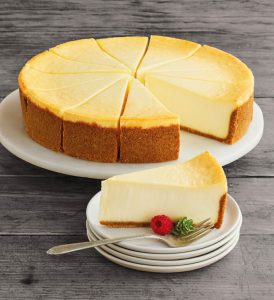The Cheesecake Story

Cheesecake has long been one of America’s favorite desserts, with annual sales exceeding $400 million. The Cheesecake Factory alone sells almost 35 million slices of its namesake each year, in addition to an untold number of whole cheesecakes. Another attribute to cheesecake’s popularity is that the cast of Golden Girls devoured over 100 of these creamy desserts during its 7 seasons, in spite of Bea Author hating them.
But have you ever wondered who invented cheesecake, and when?
Our story begins in Greece more than 4,000 years ago on the small island of Samos in the Aegean Sea. There is evidence that shows the Greeks enjoyed cheesecake in 776 B.C. during the first Olympic Games. Cheesecake at that time was usually reserved for weddings as well as other special and religious events.
The first cheesecakes known as “plakous,” were simply made using only flour, wheat, honey, and cheese, a far distant cousin to the more complicated variations found throughout the world today. Although Greece had been making their ancient cheesecakes for some 2,000 years, it was not until 230 A.D. that Greek writer Athenaeus wrote down what is believed to be the first known recipe.
When the Romans conquered Greece in 146 A.D., they made cheesecake their own by adding eggs and crushed cheese. They called their cheesecake “libuma,” or sometimes “placenta.” And like the Greeks, the Romans reserved libuma for special occasions, as well as an offering to their gods. In the 1st century A.D. Marcus Cato, a Roman physician and politician, included in his writings De Agricultura a recipe for libuma, which called for “2 pounds of cheese well crushed in a mortar, 1 pound bread-wheat flour, and 1 egg. Mix together well and form into a loaf and bake slowly under a brick and serve warm.”
From Rome, cheesecake spread throughout Europe, and eventually to the Middle East, North Africa and Russia, with each region adding their own unique twist based on culture and available ingredients.
It didn’t take long before cooks throughout Europe began experimenting with a variety of techniques and ingredients in an attempt to make cheesecake uniquely their own. Even early European royalty got in on the act with each king trying to outdo the other. King Richard II had his chef write Forma di Cury featuring a cheese tart and another cheesecake recipe. Then in 1545, King Henry VIII commissioned A Proper New Booke of Cokerye, thought to be the first printed cookbook and included the King’s favorite cheesecake recipe.
So popular had cheesecake become in Europe that it’s no surprise the early American colonists brought with them both their love and recipes for this delicacy. In the 1730s Philadelphia had the Cheesecake House Tavern where one could enjoy a slice with their ale. In 1749 Martha Washington’s first husband Daniel Custis gave her the Booke of Cookery and Booke of Sweetmeats as a wedding gift. It contained three cheesecake recipes and a baked “Curd Pudding,” a cheesecake without a crust.
 In 1872, American dairyman William Lawrence of Chester, New York accidentally invented cream cheese while trying to reproduce Neufchâtel. This new cheese was distributed in a foil wrap under the name of Philadelphia (yes, the same brand available today); enabled Americans to produce cheesecake with a more dense and creamer texture than was previously possible.
In 1872, American dairyman William Lawrence of Chester, New York accidentally invented cream cheese while trying to reproduce Neufchâtel. This new cheese was distributed in a foil wrap under the name of Philadelphia (yes, the same brand available today); enabled Americans to produce cheesecake with a more dense and creamer texture than was previously possible.
While cream cheese recipes such as “Cream Cheese Pie” and “Cream Cheese Cake” were published in late 19th and early 20th century cookbooks, it was the mid-1920s and the addition of stabilizers in its production that Americans began experimenting in earnest with using this new cheese in their baking. Previous to this addition, cream cheese would “break” and become grainy during the baking process.
 Enter Arnold Reuben, a German-Jewish immigrant restaurateur and inventor of his very popular namesake sandwich of corned beef, Swiss cheese and sauerkraut on grilled rye. As the story goes, in 1929 Reuben attended a dinner party where he was taken by the cheese pie served for dessert. After acquiring the recipe from his hostess, he began experimenting with replacing the curds with cream cheese. By the early 1930s Rueben began serving his new cheesecake, dubbed New York Cheesecake, in his Turf Restaurants where it garnered high raves from customers.
Enter Arnold Reuben, a German-Jewish immigrant restaurateur and inventor of his very popular namesake sandwich of corned beef, Swiss cheese and sauerkraut on grilled rye. As the story goes, in 1929 Reuben attended a dinner party where he was taken by the cheese pie served for dessert. After acquiring the recipe from his hostess, he began experimenting with replacing the curds with cream cheese. By the early 1930s Rueben began serving his new cheesecake, dubbed New York Cheesecake, in his Turf Restaurants where it garnered high raves from customers.
While it was Rueben who introduced New York to the cream cheese cheesecake, it was Leo “Lindy” Lindemann who brought it into the forefront. In 1921, Lindy and his wife Clara opened a deli in Manhattan’s theater district. Said to have hired Reuben’s baker, Lindy’s featured a cheesecake topped with a strawberry gel.
Today most cheesecakes produced in the United States use cream cheese as the primary ingredient, although there are numerous variations. Probably the two most popular U.S. cheesecakes are Junior’s in New York and Eli’s in Chicago.
Did you know that cheesecake is not really a cake? Because it contains eggs and no flour it’s actually classified as a custard pie, although some consider it a flan, tart, or torte.
But whether you think of it as cake, pie, or a flan, there are two basic varieties of cheesecake—baked and unbaked. And among baked cheesecake in this country, probably the two most popular styles are New York and Chicago:
- New York style cheesecake is probably the most popular, using a cream cheese base, sometimes with the addition of sour cream or heavy cream, to produce an extremely dense, but smooth and creamy texture. It is usually baked in a graham cracker crust.
- Chicago style cheesecake is known for its firm outside and soft creamy center which comes from extra cream cheese added to the batter. Chicago cheesecakes are baked in springform pans with crushed shortbread crust Although today some New York bakers use shortbread crusts and some Chicago bakers prefer the graham cracker crust.
Almost every nation on the planet has its own take on cheesecake. Some of those styles and variations include: - Asian cheesecakes are usually light, spongy and contain a lot less sugar than many of their counterparts. They generally favor flavors such as green tea, lychee, and mango, although there are variations from country to country.
- Japan uses a cornstarch and egg base resulting in a plastic-like texture.
- In the Philippines the most popular cheesecake is made with a combination of cream cheese and purple yams, yielding its characteristic purple color.
- Indian cheesecake is made with a type of cottage cheese mixed with sugar and nuts.
- European regions offer numerous cheesecake variations, both in their base and flavor profiles.
- In France cheesecakes are typically very light and thinner than American cheesecake. The French utilize Neufchâtel cheese and gelatin as their base.
- German style cheesecake is made using a homemade cheese known as quark that resembles cottage cheese. Its also made with fresh dough instead of cracker or cookie crumbs.
- Today the Greeks use mizithra, a goat and/or sheep milk cheese, that resembles Italian ricotta.
- Modern Italian cheesecake is made using ricotta or mascarpone cheese, sugar, vanilla and a touch of orange flower water. It’s typically baked in a flour crust with lattice top. Sometimes candy fruits are added.
- Ireland and the UK use a filling of cream cheese, cream and gelatin flavored with coffee, tea, Irish cream, chocolate, and even marshmallows. They are refrigerated rather than baked and almost always topped with a fruit compote. The Scots even make a savory cheesecake flavored with smoked salmon.
-
Poland, Portugal, Dutch, Russia and other European countries each have their own cheesecake variations as well, using local cheese and flavors.
So there you have it—a brief story how cheesecake was born and evolved over the past 4,000 years. And for those adventurous souls among you who might want to try your hand at baking one, I’ve included my recipe for the popular New York style cheesecake. Looking for something a little less ordinary? Try preparing the Italian cheesecake. Both are delicious and fun to make. Make Em: New York Style Cheesecake, Italian Ricotta Cheesecake




